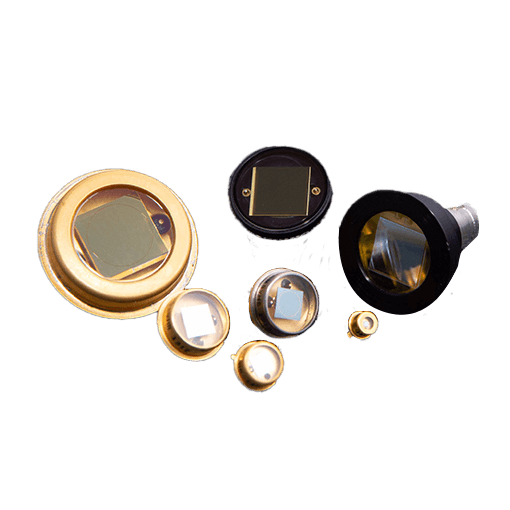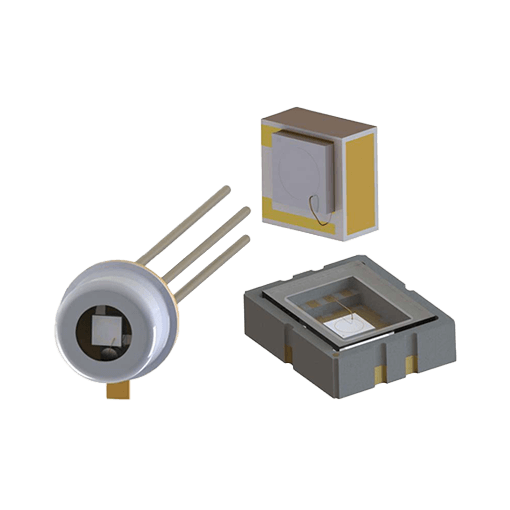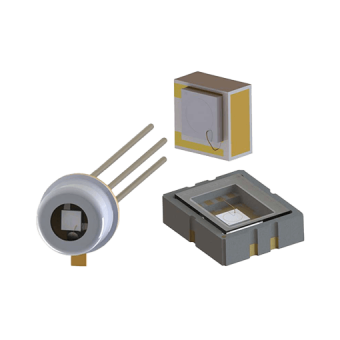Germanium photodiodes are commonly used to measure optical power in the NIR range, especially in cost-sensitive applications or where a large-area detector is needed. However, germanium detectors have a lower shunt resistance and higher dark current than similarly-sized InGaAs detectors, resulting in higher noise levels overall. Therefore, germanium detectors are well suited for applications where the signal being detected is much higher than the noise floor. GPD Optoelectronics offers an “HS” series of germanium photodiodes which have higher-than-typical shunt resistance for improved performance.
10 x 10 mm Diameter Germanium Photodiode Performance Specifications
Figure1-Responsivity vs. Wavelength
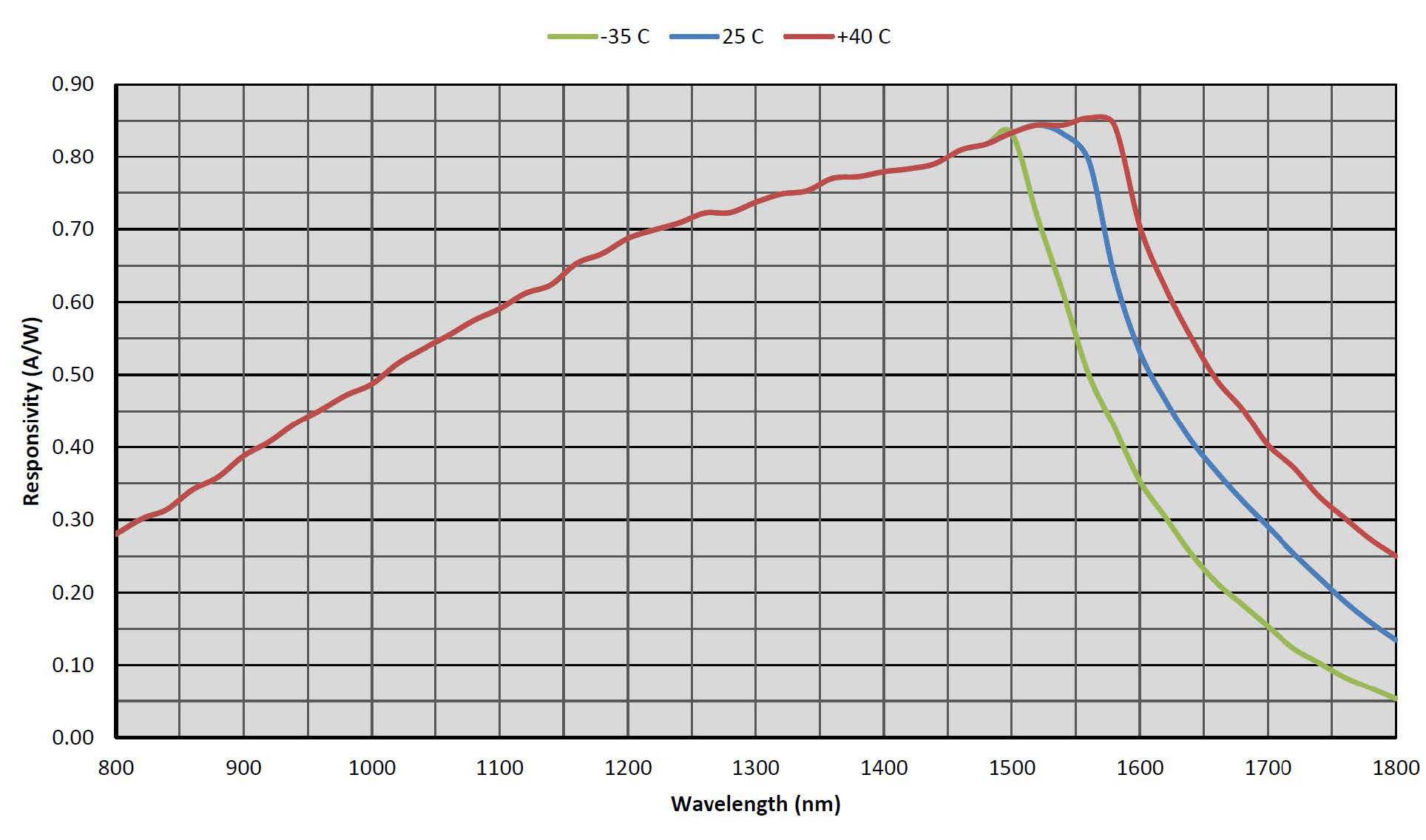
Figure 2-Capacitance vs. Reverse Bias
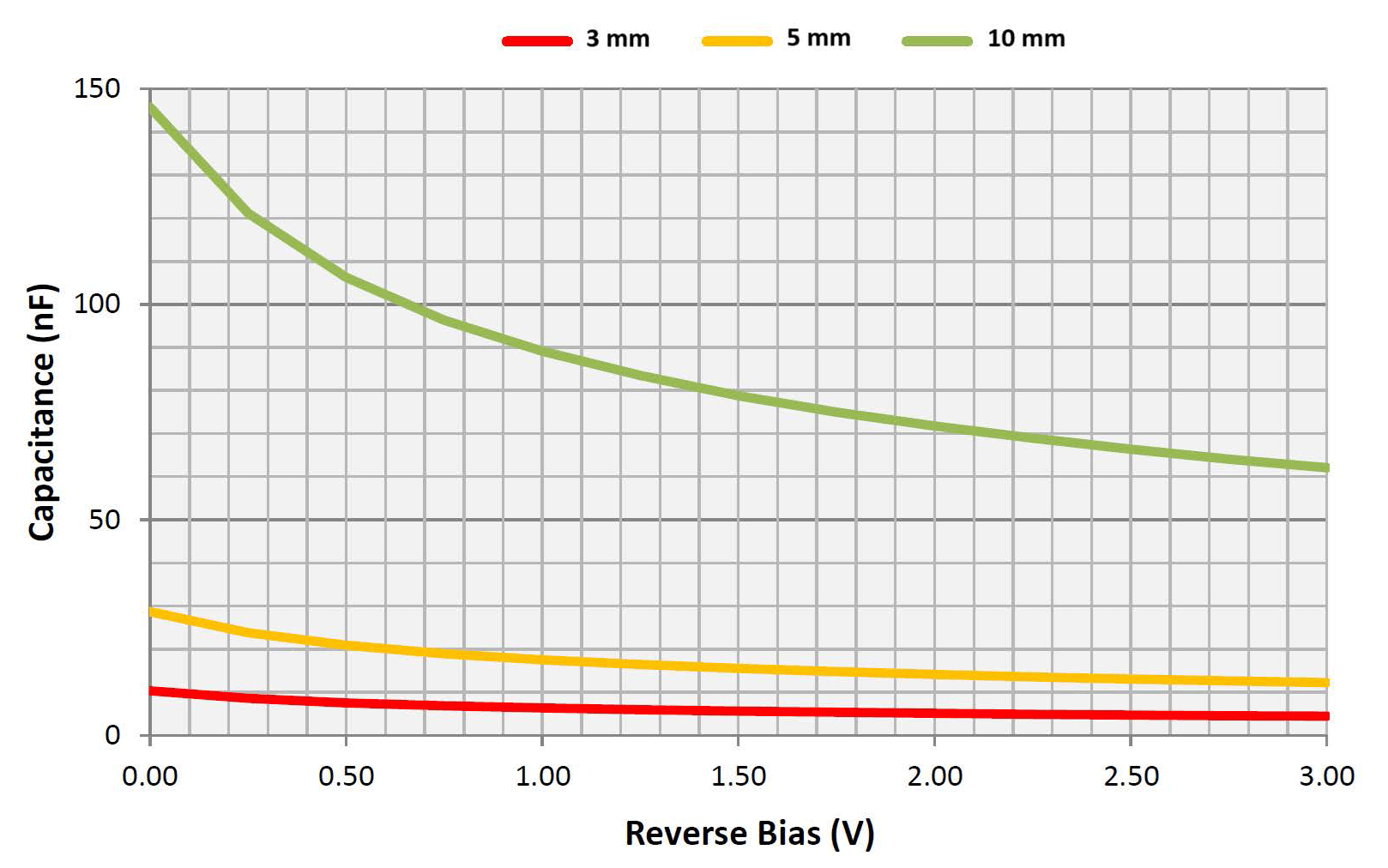
-
Features
- Chip diameters from 1 mm to 25 mm
- Spectral response from 800 nm to 1700 nm
- High linearity > 10 dBm
- Multiple window and lens options
- Optical filters available (neutral density, bandpass, etc.)
- Thermoelectric cooling options
- Wide packaging variety: TO packages, BNC options, chip on ceramic submount, and more
-
Applications
- Optical power meters
- LED/LD characterization and burn-in diagnostics
- Spectroscopy
- LED/LD characterization
- Eye-safe laser detection sensors
-
Packaging Capablilities
| Packaging Configurations | ||||||||
| Size | TO Headers | Ceramic Leadless Chip Carriers |
||||||
| TO-46 | TO-18 | TO-5 | TO-8 | TO-9 | LCC-6 | LCC-28 | BNC | |
| 1 mm dia. | ● | ● | ● | |||||
| 2 mm dia. | ● | ● | ||||||
| 3 mm dia. | ● | ● | ● | |||||
| 5 mm dia. | ● | ● | ● | |||||
| 10x10 mm | ● | ● | ||||||
| Window (Other Options Available) | ||||||||
| Material | Molded Clear Glass | Sapphire | Borosilicate Glass | |||||
| Thickness (mm) | 0.25 | 0.5 | 0.5 | |||||
-
Specifications
1 mm Diameter Germanium Photodiode Performance Specifications
| Part Number | GB100-XX | GH100-XX | GV100-XX | |
| Optoelectronic Characteristics @ 23 ºC ± 2 ºC | Units | |||
| RSHUNT @ 10mV (min/typ) | 20/40 | 60/100 | 200/280 | kΩ |
| IDARK (max) | 4 | 1.5 | 0.5 | μA |
| Capacitance (max) | 95 | 300 | 1500 | pF |
| VREVERSE | 15 | 2 | 0.3 | V |
| NEP (typ) | 1.5 | 1 | 0.6 | pW/Hz1/2 |
| Maximum Reverse Voltage | 15 | 3 | 0.3 | V |
2 mm Diameter Germanium Photodiode Performance Specifications
| Part Number | GB200-XX | GH200-XX | GV200-XX | |
| Optoelectronic Characteristics @ 23 ºC ± 2 ºC | Units | |||
| RSHUNT @ 10mV (min/typ) | 6/12 | 30/60 | 80/120 | kΩ |
| IDARK (max) | 10 | 3 | 1 | μA |
| Capacitance (max) | 360 | 2200 | 7000 | pF |
| VREVERSE | 10 | 2 | 0.3 | V |
| NEP (typ) | 3 | 1.4 | 0.8 | pW/Hz1/2 |
| Maximum Reverse Voltage | 15 | 3 | 0.5 | V |
3 mm Diameter Germanium Photodiode Performance Specifications
| Part Number | GB300-XX | GH300-XX | GV300-XX | |
| Optoelectronic Characteristics @ 23 ºC ± 2 ºC | Units | |||
| RSHUNT @ 10mV (min/typ) | 4/8 | 25/35 | 40/65 | kΩ |
| IDARK (max) | 20 | 4 | 2 | μA |
| Capacitance (max) | 1200 | 7000 | 14000 | pF |
| VREVERSE | 5 | 1 | 0.25 | V |
| NEP (typ) | 4 | 2 | 1 | pW/Hz1/2 |
| Maximum Reverse Voltage | 10 | 3 | 0.5 | V |
5 mm Diameter Germanium Photodiode Performance Specifications
| Part Number | GB500-XX | GH500-XX | GV500-XX | |
| Optoelectronic Characteristics @ 23 ºC ± 2 ºC | Units | |||
| RSHUNT @ 10mV (min/typ) | 2/4 | 10/15 | 15/20 | kΩ |
| IDARK (max) | 30 | 10 | 5 | μA |
| Capacitance (max) | 3000 | 17000 | 40000 | pF |
| VREVERSE | 3 | 1 | 0.1 | V |
| NEP (typ) | 5 | 3 | 2 | pW/Hz1/2 |
| Maximum Reverse Voltage | 10 | 3 | 0.3 | V |
10 x 10 mm Diameter Germanium Photodiode Performance Specifications
| Part Number | GB10M-XX | GH10M-XX | GV10M-XX | |
| Optoelectronic Characteristics @ 23 ºC ± 2 ºC | Units | |||
| RSHUNT @ 10mV (min/typ) | Contact us for more information |
2/3.5 | Contact us for more information |
kΩ |
| IDARK (max) | 50 | μA | ||
| Capacitance (max) | 90000 | pF | ||
| VREVERSE | 0.5 | V | ||
| NEP (typ) | 6 | pW/Hz1/2 | ||
| Maximum Reverse Voltage | 1 | V | ||
GB Series: Designed for high-speed applications with reverse bias >5V
GH Series: Designed for applications with reverse bias <5 V
GV Series: Designed for zero bias applications
GH Series: Designed for applications with reverse bias <5 V
GV Series: Designed for zero bias applications
-
Standard Products
|
Opto/Electronic Characteristics @ 23 ºC ± 2 ºC
|
Units | |||||||||||||
| Active Diameter | 1 | 1 | 1 | 2 | 2 | 2 | 3 | 3 | 3 | 5 | 5 | 5 | 10×10 | mm |
| Part Number | GB100-T18 GB100-LCC6 |
GH100-T18 GH100-LCC6 |
GV100-T18 GV100-LCC6 |
GB200-T5 GB200-LCC6 |
GH200-T5 GH200-LCC6 |
GV200-T5 GV200-LCC6 |
GB300-T5 GB300-LCC28 |
GH300-T5 GH300-LCC28 |
GV300-T5 GV300-LCC28 |
GB500-T8 GB500-LCC28 |
GH500-T8 GH500-LCC28 |
GV500-T8 GV500-LCC28 |
GH10M-T9 GH10M-LCC28 |
|
| Legacy Part Number | GM5 | GM5HS | GM5VHS | GM6 | GM6HS | GM6VHS | GM7 | GM7HS | GM7VHS | GM8 | GM8HS | GM8VHS | GM10HS | |
| Spectral Response | 800-1800 | nm | ||||||||||||
| Rλ(typ)@ 850 nm | 0.26 | A/W | ||||||||||||
| Rλ(typ) @ 1300 nm | 0.70 | A/W | ||||||||||||
| Rλ(typ)@ 1550 nm | 0.85 | A/W | ||||||||||||
| RSHUNT (min/typ) | 20/40 | 60/100 | 200/280 | 6/12 | 30/60 | 80/120 | 4/8 | 25/35 | 40/65 | 2/4 | 10/15 | 15/20 | 2/3.5 | kΩ |
| IDARK (max) | 3 | 1.5 | 0.5 | 10 | 3 | 1 | 30 | 4 | 3 | 40 | 15 | 5 | 50 | μA |
| CDIODE (max) | 85 | 300 | 1,450 | 300 | 1,200 | 9,000 | 800 | 4,000 | 13,000 | 3,000 | 6,000 | 35,000 | 30,000 | pF |
| VREVERSE | 10 | 2 | 0.3 | 10 | 2 | 0.3 | 5 | 1 | 0.25 | 3 | 1 | 0.1 | 0.5 | V |
| NEP | 1.5 | 1 | 0.6 | 3 | 1.4 | 0.8 | 4 | 2 | 1 | 5 | 3 | 2 | 6 | pW/Hz1/2 |
| Linearity | 8 | 8 | 8 | 8 | 8 | 8 | 8 | 8 | 8 | 8 | 8 | 8 | 8 | dB |
| TO Packages | TO-18 | TO-18 | TO-18 | TO-5 | TO-5 | TO-5 | TO-5 | TO-5 | TO-5 | TO-8 | TO-8 | TO-8 | TO-9 | |
| Leadless Chip Carrier | LCC-6 | LCC-6 | LCC-6 | LCC-6 | LCC-6 | LCC-6 | LCC-28 | LCC-28 | LCC-28 | LCC-28 | LCC-28 | LCC-28 | Hybrid | |
| Storage Temperature | -40 to 125 | ºC | ||||||||||||
| Operating Temperature | -40 to 85 | ºC | ||||||||||||
| Max Reverse Voltage | 15 | 3 | 0.3 | 15 | 3 | 0.5 | 10 | 3 | 0.5 | 5 | 3 | 0.3 | 1 | V |
| Max Reverse Current | -10 | mA | ||||||||||||
| Max Forward Current | 10 | mA | ||||||||||||
Figure1-Responsivity vs. Wavelength

Figure 2-Capacitance vs. Reverse Bias

Figure 3-Dark Current vs. Reverse Bias
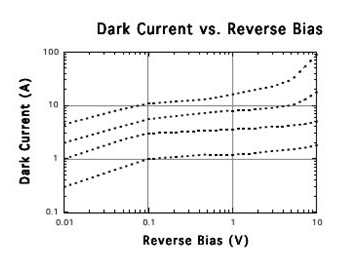
Figure 4-Shunt Resistance vs. Temperature
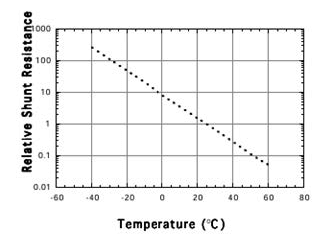
Figure 5. Photocurrent vs. Input Power
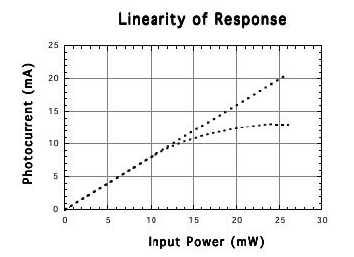

Figure 4-Shunt Resistance vs. Temperature

Figure 5. Photocurrent vs. Input Power


